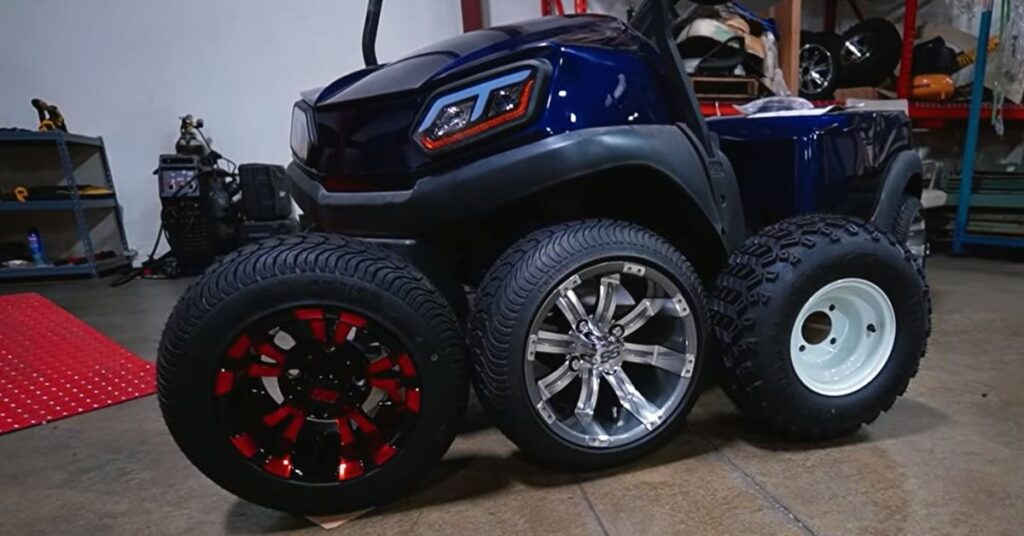How to Change a Golf Cart Tire: A Step-by-Step Guide!
Imagine a perfect day on the golf course, the sun shining brightly overhead, and you’re about to make that perfect swing. Suddenly, you notice a flat tire on your golf cart.
This seemingly small issue can ruin your entire day. Knowing how to change a golf cart tire is an essential skill that every golf enthusiast should have in their arsenal. Proper tire maintenance not only ensures a smooth ride but also prolongs the lifespan of your golf cart.
In this ultimate guide, we’ll walk you through the entire process of changing a golf cart tire, making it easy and engaging for you to tackle this task independently.

What tools do you need to change a golf cart tire?
A captivating beginning starts with having the right tools and materials on hand. Before diving into the tire-changing process, let’s take a moment to identify the essential tools you’ll need to get the job done.
- New tire: Make sure to have a replacement tire that matches the size and specifications of the one you’re replacing.
- Jack: A hydraulic floor jack or scissor jack is needed to lift the golf cart off the ground. Ensure that the jack is rated to handle the weight of your golf cart.
- Jack stands (optional): Jack stands can provide extra stability and safety while working on the golf cart, especially if you’re replacing more than one tire.
- Lug wrench or tire iron: This tool removes and tightens the lug nuts holding the wheel. Use the correct size for your golf cart’s lug nuts.
- Air compressor or tire pump: You’ll need this to inflate the new tire to the proper air pressure. Check your golf cart’s owner’s manual or the tire’s sidewall for the recommended PSI.
- Valve stem tool (optional): If you need to replace or transfer the valve stem to the new tire, a valve stem tool will make the job easier.
- Torque wrench (optional): A torque wrench helps ensure that you tighten lug nuts to the manufacturer’s recommended torque specifications, reducing the risk of over-tightening or under-tightening.
- Wheel chocks (optional): Placing wheel chocks behind the tires opposite the one you’re working on can help prevent the golf cart from rolling while it’s lifted.
- Work gloves: Wearing gloves can protect your hands from dirt, grease, and potential injury.
- Safety glasses (optional): Safety glasses can help protect your eyes from any debris or dust that may come loose during the tire change process.
Step-by-Step Guide to Changing a Golf Cart Tire
With safety precautions in place and the necessary tools, you’re ready to tackle changing your golf cart tire. Follow these step-by-step instructions to ensure a successful tire change:
Step 1: Park the golf cart on a level surface
Make sure the parking brake is engaged. Turn off the cart and remove the key. Place wheel chocks or bricks behind the opposite wheels to prevent the cart from rolling.
Step 2: Loosen the lug nuts
Use the lug wrench or socket wrench to loosen the lug nuts on the flat tire, but do not remove them completely yet. Loosening them before lifting the cart will make it easier to remove the wheel later.
Step 3: Lift the golf cart
Position the jack under the frame or axle of the cart near the flat tire, making sure it’s in a stable and secure spot.
Slowly raise the jack until the flat tire is off the ground. Make sure you have enough clearance to remove the tire and install the new one.
Place a jack stand under the frame or axle near the jack to support the cart’s weight for added safety.
Step 4: Remove the flat tire
Finish unscrewing the lug nuts and set them aside. Carefully remove the flat tire from the wheel hub.
Step 5: Install the new or spare tire
Align the holes in the new or spare tire with the wheel studs on the hub. Slide the tire onto the wheel hub.
Hand-tighten the lug nuts onto the wheel studs, making sure they are correctly threaded.
Step 6: Lower the golf cart
Slowly lower the jack, ensuring that the new tire is seated correctly on the ground. Remove the jack stand if you used one.
Step 7: Tighten the lug nuts
Use the lug wrench or socket wrench to tighten the lug nuts in a star pattern. This ensures even pressure and helps prevent the wheel from warping.
Check the lug nuts for proper tightness by attempting to turn them further with the wrench. If they don’t budge, they are tight enough.
Step 8: Remove the wheel chocks or bricks and check the tire pressure
Make sure the new or spare tire is inflated to the manufacturer’s recommended pressure.
Step 9: Test drive the golf cart
Drive the cart for a short distance to ensure that the new tire is seated correctly and that there are no issues with the installation.
Golf cart tire maintenance tips and tricks
Proper golf cart tire maintenance is crucial to ensure a smooth ride and optimal performance. Keep your golf cart in top shape with these tips and tricks:
- Regular inspection: Routinely check your golf cart tires for wear, punctures, or damage. Inspect the tread and sidewalls, and address any issues promptly.
- Maintain correct air pressure: Consult your golf cart owner’s manual for the recommended tire pressure. Underinflated or overinflated tires can cause uneven wear, poor performance, and a bumpy ride.
- Rotate tires: Just like with cars, it’s essential to rotate your golf cart tires periodically. This helps to distribute wear evenly, prolonging tire life.
- Balance tires: Balancing your golf cart tires ensures a smoother ride and reduces vibrations that can lead to premature wear.
- Clean tires regularly: Remove debris and dirt from your tires to prevent damage and ensure optimal traction on the golf course.
- Replace worn or damaged tires: When the tread on your tires is worn or you notice signs of damage, it’s time to replace them. Riding on worn tires can negatively impact your golf cart’s performance and safety.
- Choose the right tires: Select golf cart tires that suit your specific needs, whether you drive mostly on the golf course, on pavement, or off-road. Different tires are designed for various terrains and conditions.
- Store properly: If you’re not using your golf cart for an extended period, store it in a cool, dry place to prevent tire damage due to exposure to heat, cold, or moisture.
By following these tips and tricks, you can extend the life of your golf cart tires and enjoy a better, safer driving experience on the golf course and beyond.
FAQs
Here are some frequently asked questions (FAQs) on changing golf cart tires. By addressing these common questions, you can better understand the process of changing golf cart tires and ensure proper maintenance and safety.
How do I know when it’s time to change my golf cart tires?
Signs that it’s time to change your golf cart tires include excessive wear, visible damage such as cracks or cuts, poor traction, and frequent flats.
Regularly inspect your tires for these issues and replace them as needed to maintain optimal performance and safety.
Can I use car or truck tires on my golf cart?
Using car or truck tires on a golf cart is generally not recommended. Golf cart tires are specifically designed for the unique needs of golf carts, including lower speeds, lighter loads, and use on turf or grass.
Always choose tires specifically made for golf carts to ensure proper fit, performance, and safety.
What is the correct tire pressure for my golf cart tires?
The correct tire pressure for your golf cart tires can usually be found in the owner’s manual or on a placard located on the cart itself.
Tire pressure can vary depending on the make and model of your golf cart, so always follow the manufacturer’s recommendations.
Can I inflate my golf cart tires with a standard air compressor?
Yes, you can use a standard air compressor to inflate your golf cart tires. Just make sure to use a tire pressure gauge to ensure you inflate the tires to the recommended pressure.
How long do golf cart tires typically last?
The lifespan of golf cart tires can vary depending on factors such as usage, terrain, and maintenance.
On average, golf cart tires can last anywhere from 3 to 5 years or more with proper care. Regularly inspect your tires for signs of wear and replace them as needed.






![Do You Wear Golf Shoes At A Simulator? [Don’t Miss out!] Do-You-Wear-Golf-Shoes-At-A-Simulator](https://giftedgolfers.com/wp-content/uploads/2023/08/Do-You-Wear-Golf-Shoes-At-A-Simulator-300x156.jpg)